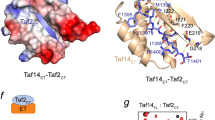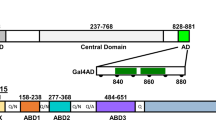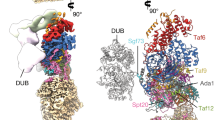Abstract
HAP1 is a yeast transcriptional activator that binds with equal affinity to the dissimilar upstream activation sequences UAS1 and UASCYC7, but activates transcription differentially when bound to each site. HAP1-18 harbors an amino acid change in the DNA binding domain. While binding UAS1 poorly, HAP1-18 binds UASCYC7 with wild-type properties and activates transcription at elevated levels relative to HAP1. We have determined the structure of HAP1-18–UASCYC7 and have compared it to HAP1–UASCYC7. Unexpectedly, the single amino acid substitution in HAP1-18 nucleates a significantly altered hydrogen bond interface between the protein and DNA resulting in DNA conformational changes and an ordering of one N-terminal arm of the protein dimer along the DNA minor groove. These observations, together with a large subset of transcriptionally defective mutations in the HAP1 DNA-binding domain that map to the HAP1-DNA interface, suggest that protein–DNA interactions may have direct allosteric effects on transcriptional activation.
This is a preview of subscription content, access via your institution
Access options
Subscribe to this journal
Receive 12 print issues and online access
$189.00 per year
only $15.75 per issue
Buy this article
- Purchase on Springer Link
- Instant access to full article PDF
Prices may be subject to local taxes which are calculated during checkout



Similar content being viewed by others
Accession codes
References
Brent, R. & Ptashne, M. Cell 43, 729–736 (1985).
Luo, X. & Sawadogo, M. Mol. Cell. Biol. 16, 1367–1375 (1996).
Mangelsdorf, D.J. et al. Cell 66, 555–561 (1991).
Mangelsdorf, D. J. et al. Cell 83, 835–839 (1995).
Lefstin, J. & Yamamoto, K.R. Nature 392, 885–888 (1998).
Kim, K.-S. & Guarente, L. Nature 343, 200–203 (1989).
Turcotte, B. & Guarente, L. Genes Devel. 6, 2001–2009 (1992).
King, D.A., Zhang, L., Guarente, L. & Marmorstein, R. Nature Struct. Biol. 6, 64–71 (1999).
Ha, N., Hellaur, K. & Turcotte, B. Nucleic Acids Res. 24, 1453– 1459 (1996).
Lefstin, J., Thoma, J. & Yamamoto, K. Gene. Devel. 8, 2842– 2856 (1994).
Kabsch, W. J. Appl. Crystallogr. 21, 916–924 (1988b).
Kabsch, W. J. Appl. Crystallogr. 21, 67–71 (1988a).
Gewirth, D., Otwinowski, Z. & Minor, W. The HKL Version 1.0 manual (Yale University Press, New Haven, Connecticut; 1993).
Marmorstein, R., Carey, M., Ptashne, M. & Harrison, S.C. Nature 356, 408–414 (1992).
Furey, W. & Swaminathan, S. Meth. Enz. 277, 590–620 (1997).
Jones, T.A., Zou, J.Y. & Cowen, S.W. Acta Crystallogr. A 47, 110– 119 (1991).
Timmerman, J. et al. J. Mol. Biol. 259, 792– 804 (1996).
Swaminathan, K., Flynn, P., Reece, R.R. & Marmorstein, R. Nature Struct. Biol. 4, 751–759 (1997).
Brünger, A.T. X-PLOR 3.1, A system for X-ray crystallography and NMR. (Yale University Press, New Haven, Connecticut; 1992).
Dodson, E.J., Winn, M. & Ralph, A. Meth. Enz.. 277, 620–633 (1997).
Brünger, A.T. & Krukowski, A. Acta Crystallogr. A46, 585–593 (1990).
Rice, L.M. & Brünger, A.T. Proteins 19, 277–290 (1994).
Acknowledgements
The authors wish to thank G. Van Duyne and M. Lewis for use of their MAR Image Plate Detector and A. Lukens, T. Strams, C. Lesburg, Y. Mo, R.Venkataramani, S. Benson, X. Li and K. Swaminathan for useful discussions. This work was supported by a grant from NIH and a junior faculty research award from the ACS to R.M.
Author information
Authors and Affiliations
Corresponding author
Rights and permissions
About this article
Cite this article
King, D., Zhang, L., Guarente, L. et al. Structure of HAP1-18–DNA implicates direct allosteric effect of protein–DNA interactions on transcriptional activation. Nat Struct Mol Biol 6, 22–27 (1999). https://doi.org/10.1038/4893
Received:
Accepted:
Issue Date:
DOI: https://doi.org/10.1038/4893
This article is cited by
-
Architecture of the CBF3–centromere complex of the budding yeast kinetochore
Nature Structural & Molecular Biology (2018)



